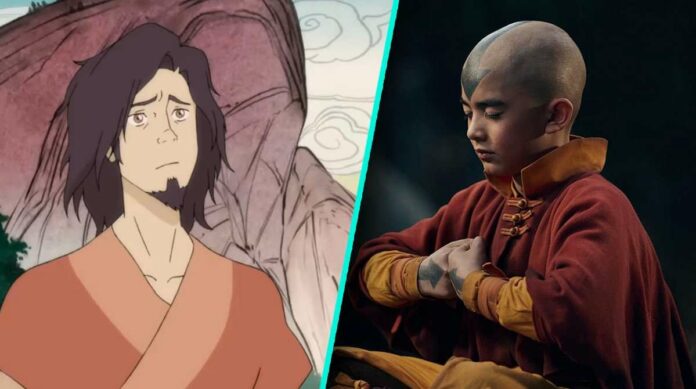One of the key reasons why Avatar: The Last Airbender has retained relevancy even after two decades since its release is its immaculate, rich world-building, which has been strongly inspired by Southeast Asian and Arctic cultures. However, occasionally, even more than the cultural influence, folklore or mythological foundation acts as the base of its story arcs, which is especially noticeable in the lore of the spirits, mystical entities representing various aspects of nature, emotions, or abstract ideas who play a significant role in the four-element bending intrigue of Avatar. There is a sense of universality that gets conveyed through the world of spirits, creating a unified, coherent structure that grants the potential for more expansive storytelling as well.
The first season of Netflix’s adaptation of Avatar incorporates the influence of spirits in the central plotline in some major ways, although the introduction was a bit abrupt as compared to the original series. However, the introduction of the spirit world hints at the scope of building the overarching narrative, which includes the origin of the Avatar, the incarnation cycle, and the creation of the world itself, into the future storyline. We would like to briefly discuss the spirits of Avatar, bring in some references from the original series to do so, and explain the connections in the first season of Netflix’s adaptation.
Spoiler Alert
Spirits Are Embedded In The Origin Of Avatar
Since the beginning of time, the two primordial spirits Raava and Vaatu, representing the cosmic binary, have remained entangled in an eternal struggle, which led to the creation of the physical realm and a parallel, mystical world of spirits. Spirits, immortal entities possessing immense powers and embodying several aspects of nature, used to cross over to the physical world and reside in the forest. On the other hand, humans lived in the safety of settlements built atop the giant lion turtles, who occasionally granted them each one of the elemental force abilities to protect themselves while venturing outside. An exiled lowlife, Wan, was granted the fire-bending ability, and while living in the forest, he developed a strong rapport with the spirits. Eventually, Wan came across the spectacle of Raava and Vaatu engaged in battle and mistakenly released the dark half, Vaatu, which unleashed dark spirits upon the world. To make amends for his action, Wan joined Raava, became the first Avatar, the master of all four elemental forces, and managed to entrap Vaatu. As the Avatar, Wan became the mediator of both the world of humans and spirits, and as the dark spirits and humans started clashing more often, he ensured the sanctity of both worlds was maintained by keeping them separate.
However, adept at their respective bending abilities, humans waged war and destruction, and in his lifetime, Wan failed to resolve the tumultuous situation. Raava promised a dying Wan that she would join him with each reincarnation to protect peace among humans and maintain the balance between both worlds as well.
While the dark spirits preyed on human vices and negative emotions, the kind, benevolent ones helped benders hone their skills further and bond strongly with the natural world. Like Wan or Aang, Avatars through the ages have been intimately associated with the spirits, and the interactions with dark spirits have proven detrimental to some as well. For example, Avatar Kuruk had lost his beloved at the hands of Koh, the faceless one, and in pursuit of eliminating dark spirits as an act of vengeance, the Avatar had lost his soul.
How Did The Spirits Influence The Events In Netflix’s Live-Action?
Although Netflix’s adaptation of Avatar doesn’t introduce the world of spirits until the midpoint of the first season, their impact on the narrative becomes pivotal later on, with the Northern Water Tribe arc culminating in the grand spectacle of Ocean Spirit’s fury being unleashed against the mighty Fire Nation armada. Since Wan’s era, several fissure points existed across the world through which barriers between the physical and spiritual worlds could have been breached, and one such was near the Fire Nation border. As seen in the fifth episode of the series, the Fire Nation’s wanton exploitative and aggressive demeanor affected the spirit world as well, as their destruction of nature directly harmed spirits like Hei Bei. Primal dark spirits like Koh harbor a disdain for both Avatar and human beings alike, which is shown duly through their interaction with Aang and co. However, in the original series, the interaction with Koh and Aang happened differently, with neither Sokka nor Katara accompanying him. Instead, in search of the Moon and Ocean spirits, namely Tui and La, Aang stumbled across Koh, one of the oldest and most knowledgeable spirits to exist, and inquired about it.
One of the important spirits whom fans barely got a chance to get acquainted with was Wan Shi Tong, the wise, giant Owl, who is seen imparting advice to Aang after he entered the spirit world. Interestingly, even though the series didn’t touch upon this aspect, Wan Shi Tong is a librarian of the great library, which holds limitless knowledge gathered from both worlds, and in the original animated series, General Zhao came to learn about the Moon and Ocean Spirit’s once-a-year descent to the physical realm from the knowledge gained from the same library.
Princess Yue’s presence was another beautiful example of how kind spirits used to act like protective guardians towards human beings, as the moon spirit had lent its essence to save the young princess’ life. Ultimately, when the world reached the verge of utter chaos after the apparent death of the Moon spirit, Princess Yue sacrificed her own life to return the life essence back to the spirit, in turn resurrecting her and saving the world as well. Spirits in Avatar are equivalent to the real world’s natural harmony, with the balance maintained by a perfect assimilation of growth and decay, and humans represent their true selves as exploitative and destructive to their very core.

